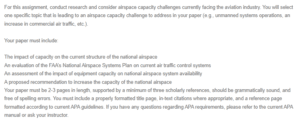Airspace Capacity Challenges
The increasing commercial air traffic is commensurate with increasing passenger volumes and the growth of airline hubs. The current issue is responsible for airport delays, financial implications, and airport as well as airspace capacities. The Federal Aviation Administration (FAA) has provided airlines with recommendations that should lead to airport capacity expansion. The FAA and National Airspace Systems (NAS) struggle to maintain a balance between forthcoming demand and airlines’ capacities. The balance between the two elements is important for avoiding a strain on the capacity of the system (Donohue, Brecht-Clarke, & Fromme, n.d).
Capacity at most airports is critical and needs to be constantly monitored to ensure that the traffic does not overwhelm the current systems. The normal runway capacity is a scarce resource that determines the airside capacity (FAA, 2004). In other cases, the taxiway, as well as apron systems, may act as the limiting constraints. During the peak period, most airports are at maximum capacity. The periodic peaks can lead to delays that an airport is unable to recover throughout the day. Such delays affect the entire industry and may become more serious as the 21st century proceeds. At least 28 percent of domestic flights were late in 31 busy airports in 2000. In the same year, 146 flights that had been scheduled arrived late 80 percent of the time (National Airspace System, 2001).
Such delays can result from other factors such as unfavorable weather, fewer passengers due to economic recessions, reduced demand, industrial action, and actions meant to improve the entire system. Insufficient capacity is identified as the second main cause of delays, which present serious challenges to the industry. However, the FAA established that weather and capacity issues are linked together. For instance, airports that have runways that run parallel to each other and are in close proximity tend to reduce take-offs and landings when weather conditions deteriorate. This is because both runways cannot be used simultaneously. During eerie weather conditions, at least 22 of 31 airports experience three 15-minute period sessions when the demand exceeds their capacity (National Airspace System, 2001). Lack of sufficient space within an airport affects operations because aircraft should maintain specific distances from each other.
The FAA released the Operational Evolution Plan (OEP), a comprehensive document that provides various initiatives that are ideal for resolving the capacity issue. Airlines have constructed new runways and found ways of ensuring that more aircraft fly safely. However, these actions may not solve the delay and congestion issues entirely. To resolve capacity problems, the expansion of current facilities was highlighted in the OEP. Airports may be expected to construct new runways, gates, and taxiways. The FAA, to ensure that airlines handle excess demand even during bad weather conditions, is still testing other potential solutions. Airports must act as passenger volumes and traffic are expected to increase. Airside capacity forecasting and planning are important for the sustenance of growth.
Recommendations from the federal government for capacity improvement include the implementation of new procedures, such as allowing aircraft to operate at lower altitudes, which would result in less congestion. In addition, the process of enhancing capacity may require the development of new technology, such as advanced satellites for navigation that enable aircraft to travel in close proximity. The government also proposes an improvement of communication with respective traffic control agencies during delays. Better communication is expected to enable the finding of solutions to congestion issues. Airline recommendations to solve this problem include scheduling flights at off-peak to avoid congestion. Adjustments of the flight times should reflect the gate-to-gate arrivals and departures (National Airspace System, 2001). The capacity-related issues that arise from increasing traffic require the contribution of all stakeholders because the effects ripple through the industry.
References
Donohue, G., Brecht-Clarke, J., & Fromme, W. (n.d). Airspace and AirportsCritical Issues for the 21st Century. Retrieved from http://onlinepubs.trb.org/onlinepubs/millennium/00003.pdf
FAA. (2004). Capacity Needs in the National Airspace System. Retrieved from https://www.faa.gov/airports/resources/publications/reports/media/NAS_needs.pdf
National Airspace System. (2001). Long-Term Capacity Planning Needed Despite Recent Reduction in Flight Delays. Retrieved from https://www.govinfo.gov/content/pkg/GAOREPORTS-GAO-02-185/pdf/GAOREPORTS-GAO-02-185.pdf
ORDER A PLAGIARISM-FREE PAPER HERE
We’ll write everything from scratch
Question
For this assignment, conduct research and consider airspace capacity challenges currently facing the aviation industry. You will select one specific topic that is leading to an airspace capacity challenge to address in your paper (e.g., unmanned systems operations, an increase in commercial air traffic, etc.).

Airspace Capacity Challenges
Your paper must include:
The impact of capacity on the current structure of the national airspace
An evaluation of the FAA’s National Airspace Systems Plan on current air traffic control systems
An assessment of the impact of equipment capacity on national airspace system availability
A proposed recommendation to increase the capacity of the national airspace
Your paper must be 2-3 pages in length, supported by a minimum of three scholarly references, should be grammatically sound, and free of spelling errors. You must include a properly formatted title page, in-text citations where appropriate, and a reference page formatted according to current APA guidelines. If you have any questions regarding APA requirements, please refer to the current APA manual or ask your instructor.

